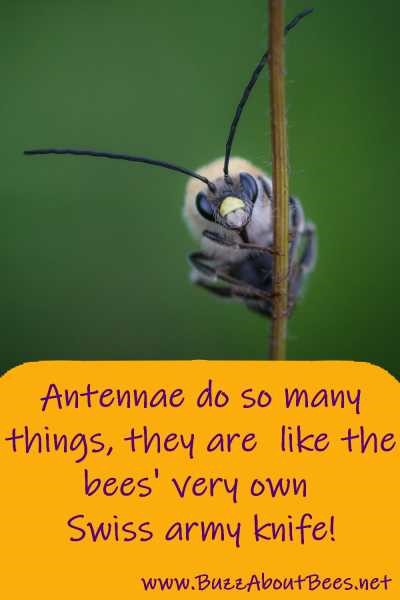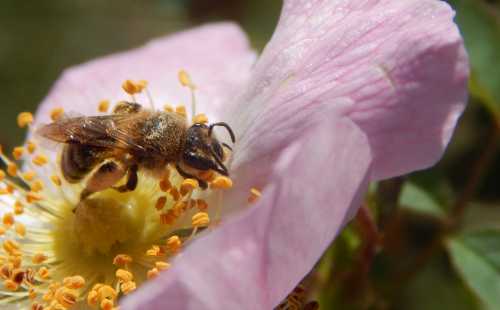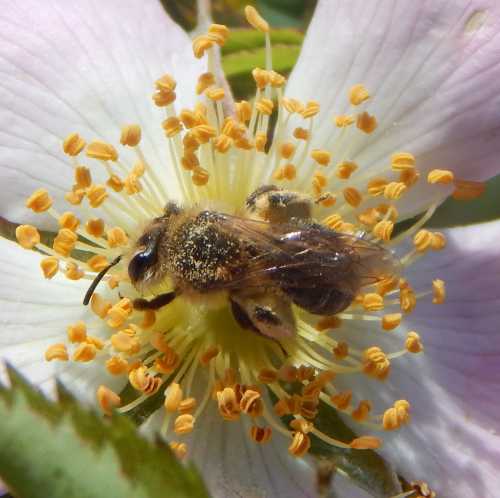Bee Antennae
The antennae of bees are amazing! They help to provide bees with the sense of smell, taste, and touch, and pick up sound vibrations.
Antennae perform a number of vital tasks, from assisting bees in locating flowers, to communication, finding a mate and more.
Quick Facts About Bee Antennae
- Bee antennae help a bee to taste, and to detect sound and scent.
- In honey bees, the taste sensors on the very tip of the antennae are more sensitive than those actually on the tongue1!
- Bee antennae are used by bees in communication.
- Male bees have longer antennae than females of the same species, but this is far more noticeable in some bee species than others.
- In some bees species, antennae have a role in courtship, with the male bee stroking the antennae of the female2!
- When honey bees sleep, their antennae droop forwards.
- 'Eucera' is a family (type) of bees. They are also known as 'longhorned bees', from the translation of 'Eucera' which is Greek for 'well-horned', and refers to the especially long antennae of the males - in fact, their antennae are longer than their bodies!
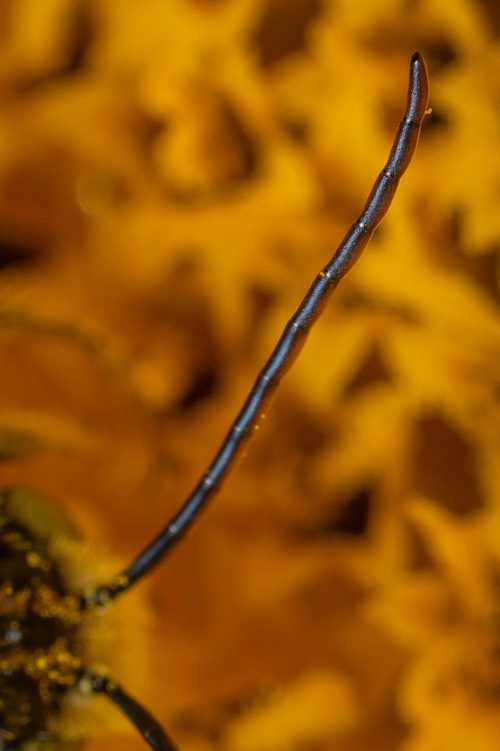 Above, clearly visible segments of an antenna. Thanks to Isaias Sanchez for sending in this image!
Above, clearly visible segments of an antenna. Thanks to Isaias Sanchez for sending in this image!The structure of bee antennae
Bee antennae comprise 3 main parts, each made up of segments. The three parts are:
- a scape, which is the first and largest single segment. The scape adjoins the head. The scape are attached to the bee's head in antennal sockets.
- a pedicel which is attached to the scape and comprises the second segment
- the rest of the segments form the third part, which is called a flagellum, which adjoins the pedicel.
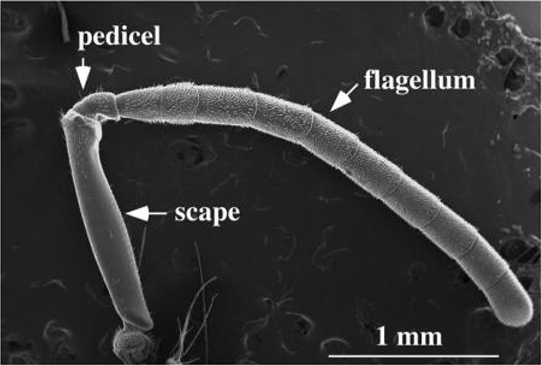 Structure of a honey bee worker antenna
Structure of a honey bee worker antennaSource: Tsujiuchi S, Sivan-Loukianova E, Eberl DF, Kitagawa Y, Kadowaki T (2007) Dynamic Range Compression in the Honey Bee Auditory System toward Waggle Dance Sounds. PLoS ONE 2(2): e234. https://doi.org/10.1371/journal.pone.0000234
Male bees have longer antennae than females of the same species. Male antennae have 13 segments in total, whereas female antennae have 12 segments.
For example, worker honey bees are female, and therefore, each antenna has 12 segments, whereas drone antennae have 13 segments.
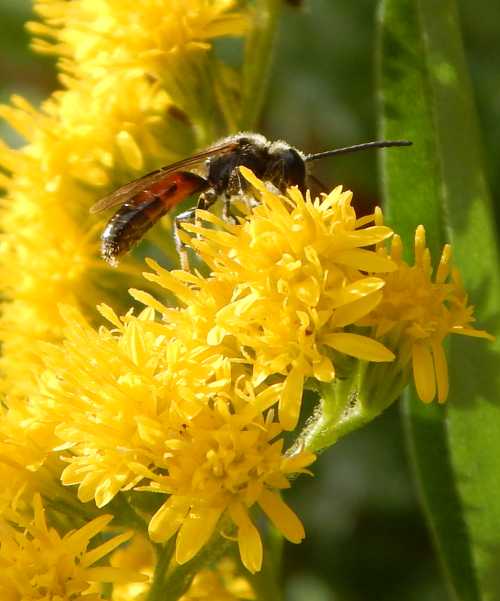 Bloomed-furrow bee male, with long antennae.
Bloomed-furrow bee male, with long antennae.What do bees' antennae do?
A bee's antennae pick up vital information from the environment in the form of sound, taste, scent and temperature via special sense organs.
- Sound
Bees do not have ears, but they are able to pick up sound waves. The pedicel in the second segment of antennae is the location of a special organ that detects sound waves that vibrate the antenna. It's called the Johnston's Organ. - Taste
Antennae are covered in tiny hairs called sensilla, which help detect taste. In fact, scientists have found over 300 taste-sensing hairs on the antennae of honey bees, with the sensors at the tip of the antennae being especially sensitive1. - Scent
The antennae sensilla also have scent-sensitive receptors which perform an important role in detecting scent2. - Temperature
Can bees sense temperature? Yes! Temperature receptors located in the bee's antennae, are acutely sensitive to temperature variations, and can sense differences of 0.25°C3.
The ability to pick up information from the environment enables bees to further make use of their antennae in a variety of ways. Which brings us to our next point:
What does a bee use its antennae for?
There are many ways in which bees use antennae. Here are just three specific examples:
Antennae assist in foraging
Because the antennae are important for the sense of smell, then the use of both antennae enables bees to detect and locate the source of a scent to a flower2.
Communication
Antennae assist communication. In honey bees it is known that the honey bee dance signals are picked up from one bee via the other, thanks to the Johnston's Organ located in the antennae4,5.
Finding a mate
Aside from, courtship, antennae can help bees find a mate. For example, honey bee drones can detect queens via scent cues picked up by the antennae. Compared with worker bees, drones have larger antennae and about seven times as many sensilla6.
Thus drones have 18,600 olfactory sensilla per antenna, each equipped with receptor neurons sensitive to the queen's sex pheromone7.
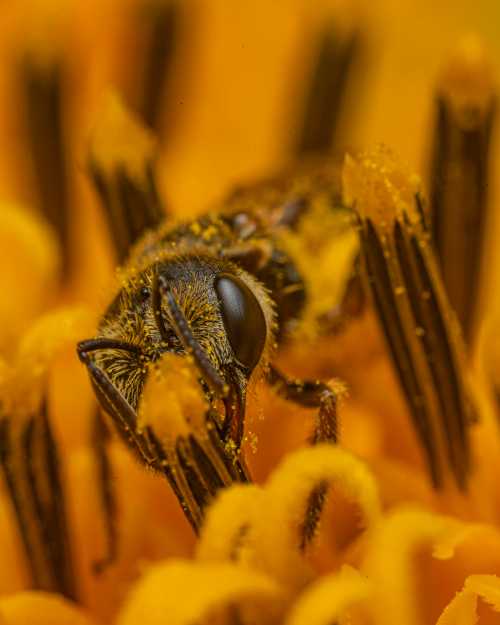 Thanks to Isaias Sanchez for sending in yet another wonderful image!
Thanks to Isaias Sanchez for sending in yet another wonderful image!How do bees clean their antennae?
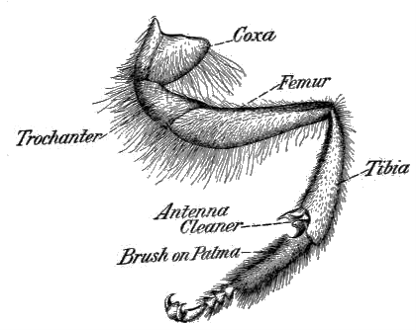 Foreleg of a worker honey bee showing antennae cleaner - by D. B. Casteel.
Foreleg of a worker honey bee showing antennae cleaner - by D. B. Casteel.Bees have a special structure on their forelegs which they use to clean their antennae.
This antennae cleaner is called a 'strigilis', which is a comb-like structure inside a curved 'notch'.
Incidentally, the name 'strigilis' may have its origins in the term used by the ancient Greeks and Romans for a curved blade or scraper used to scrape dirt and sweat from their bodies.
As far as can be ascertained, all bees have strigilis on their forelegs, and a study (Schönitzer 2009)8 examining 175 species of bee found there are slight differences between the structure of antennae cleaners among species.
Do all bees clean their antennae in the same way?
A study (Schönitzer 1986)9 of antennae grooming in more than 100 species of bees from 34 genera of the 7 major bee families found that most species are either:
- Uniscrapers
Meaning they predominantly clean their antennae with one stroke.
Almost all species of Melittidae, Megachilidae, Apidae, and Anthophoridae (except Ceratina and Nomada) are uniscrapers;
or - Biscrapers
Meaning they mostly use two strokes, one after the other.
Most species of the families Colletidae, Halictidae, and Andrenidae, as well as the species of the genera Ceratina and Nomada (Anthophoridae) are biscrapers.
The study also found that in several species, males and females differ with respect to their antenna cleaning behaviour, and females tend to be more uniscraping.
What type of antennae do bees have?
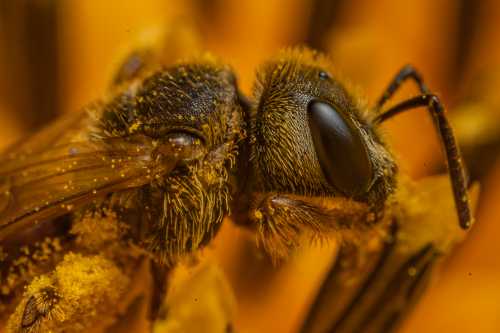 Genticulate antennae have an obvious 'elbow' or 'knee'. Image by Isaias Sanchez.
Genticulate antennae have an obvious 'elbow' or 'knee'. Image by Isaias Sanchez.Many bees have 'genticulate' antennae.
Genticulate antennae have an abrupt bend or elbow located part of the way along the antennae, between the scape and the pedicel.
Bumble bees and honey bees have genticulate antennae, along with many other bees species, but not all. For example, some solitary species have filiform antennae.
br>
References
1. Maria Gabriela de Brito Sanchez, Taste Perception in Honey Bees, Chemical Senses, Volume 36, Issue 8, October 2011, Pages 675–692, https://doi.org/10.1093/chemse/bjr040
2. Solitary Bees - by Ted Benton - p. 46. & 101.
3. Rands SA, Whitney HM. Floral temperature and optimal foraging: is heat a feasible floral reward for pollinators? PLoS One. 2008 Apr 23;3(4):e2007. doi: 10.1371/journal.pone.0002007. PMID: 18431488; PMCID: PMC2292243.
4. Tsujiuchi S, Sivan-Loukianova E, Eberl DF, Kitagawa Y, Kadowaki T. Dynamic range compression in the honey bee auditory system toward waggle dance sounds. PLoS One. 2007;2(2):e234. Published 2007 Feb 21. doi:10.1371/journal.pone.0000234
5. Ai H, Rybak J, Menzel R, Itoh T. Response characteristics of vibration-sensitive interneurons related to Johnston's organ in the honeybee, Apis mellifera. J Comp Neurol. 2009 Jul 10;515(2):145-60. doi: 10.1002/cne.22042. PMID: 19412925.
6. A honey bee odorant receptor for the queen substance 9-oxo-2-decenoic acid Kevin W. Wanner, Andrew S. Nichols, Kimberly K. O. Walden, Axel Brockmann, Charles W. Luetje, Hugh M. Robertson Proceedings of the National Academy of Sciences Sep 2007, 104 (36) 14383-14388; DOI: 10.1073/pnas.0705459104
7. Brockmann A, Brückner D. Structural differences in the drone olfactory system of two phylogenetically distant Apis species, A. florea and A. mellifera. Naturwissenschaften. 2001 Feb;88(2):78-81. doi: 10.1007/s001140000199. PMID: 11320892.
8. Schönitzer, B.K. (1986), Comparative morphology of the antenna cleaner in bees (Apoidea). Journal of Zoological Systematics and Evolutionary Research, 24: 35-51. https://doi.org/10.1111/j.1439-0469.1986.tb00614.x
9. SCHÖNITZER, K. (1986), Quantitative Aspects of Antenna Grooming in Bees (Apoidea: Hymenoptera). Ethology, 73: 29-42. https://doi.org/10.1111/j.1439-0310.1986.tb00997.x
br>
br>
If you found this page helpful or interesting, I'd really be grateful if you would share it with others - if not this page, perhaps another, such as Gardening For Bees.
Thank you so much :) .
